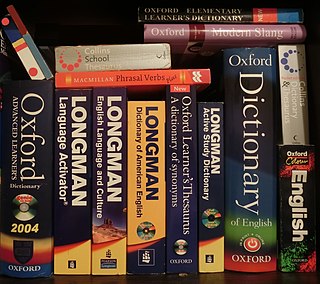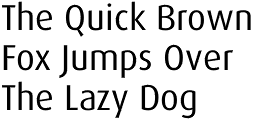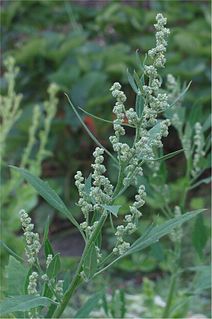Related Research Articles
An abbreviation is a shortened form of a word or phrase, by any method. It may consist of a group of letters, or words taken from the full version of the word or phrase; for example, the word abbreviation can itself be represented by the abbreviation abbr., abbrv., or abbrev.; NBM, for nil by mouth is an abbreviated medical instruction. It may also consist of initials only, a mixture of initials and words, or words or letters representing words in another language. Some types of abbreviations are acronyms, initialisms, or grammatical contractions or crasis.
The English language was first introduced to the Americas by British colonisation, beginning in the late 16th and early 17th centuries. The language also spread to numerous other parts of the world as a result of British trade and colonisation and the spread of the former British Empire, which, by 1921, included about 470–570 million people, about a quarter of the world's population. Written forms of British and American English as found in newspapers and textbooks vary little in their essential features, with only occasional noticeable differences.
English orthography is the system of writing conventions used to represent spoken English in written form that allows readers to connect spelling to sound to meaning.
Wade–Giles is a romanization system for Mandarin Chinese. It developed from a system produced by Thomas Francis Wade, during the mid-19th century, and was given completed form with Herbert A. Giles's Chinese–English Dictionary of 1892.

English nouns are inflected for grammatical number, meaning that if they are of the countable type, they generally have different forms for singular and plural. This article discusses the variety of ways in which English plural nouns are formed from the corresponding singular forms, as well as various issues concerning the usage of singulars and plurals in English. For plurals of pronouns, see English personal pronouns.
The apostrophe character is a punctuation mark, and sometimes a diacritical mark, in languages that use the Latin alphabet and some other alphabets. In English it is used for three purposes:
The hyphen‐ is a punctuation mark used to join words, and to separate syllables of a single word. The use of hyphens is called hyphenation. Non-hyphenated is an example of a hyphenated word. The hyphen should not be confused with dashes, which are longer and have different uses, or with the minus sign −, which is also longer and more vertically centred in some typefaces.
Capitalization or capitalisation is writing a word with its first letter as a capital letter and the remaining letters in lower case, in writing systems with a case distinction. The term also may refer to the choice of the casing applied to text.

Romanization of Korean refers to systems for representing the Korean language in the Latin script. Korea's alphabetic script, called Hangul, has historically been used in conjunction with Hanja, though such practice has become infrequent.

The modern English alphabet is a Latin alphabet consisting of 26 letters, each having an upper- and lower-case form. It originated around the 7th century from the Latin script. Since then, letters have been added or removed to give the current Modern English alphabet of 26 letters. The word alphabet is a compound of first two letters of the Greek alphabet, alpha and beta.

New York Point is a braille-like system of tactile writing for the blind invented by William Bell Wait (1839–1916), a teacher in the New York Institute for the Education of the Blind. The system used one to four pairs of points set side by side, each containing one or two dots. The most common letters are written with the fewest points, a strategy also employed by the competing American Braille.

Chenopodium album is a fast-growing weedy annual plant in the genus Chenopodium. Though cultivated in some regions, the plant is elsewhere considered a weed. Common names include lamb's quarters, melde, goosefoot, manure weed, wild spinach and fat-hen, though the latter two are also applied to other species of the genus Chenopodium, for which reason it is often distinguished as white goosefoot. Chenopodium album is extensively cultivated and consumed in Northern India as a food crop known as bathua.

Chenopodium is a genus of numerous species of perennial or annual herbaceous flowering plants known as the goosefoots, which occur almost anywhere in the world. It is placed in the family Amaranthaceae in the APG II system; older classification systems, notably the widely used Cronquist system, separate it and its relatives as Chenopodiaceae, but this leaves the rest of the Amaranthaceae polyphyletic. However, among the Amaranthaceae, the genus Chenopodium is the namesake member of the subfamily Chenopodioideae.
A compound modifier is a compound of two or more attributive words: that is, two or more words that collectively modify a noun. Compound modifiers are grammatically equivalent to single-word modifiers, and can be used in combination with other modifiers.
Chenopodium nuttalliae is species of edible plant native to Mexico. It is known by the common name huauzontle. Other variations of the name include huauhzontle, huanzontle, and guausoncle. It is related to other commonly-consumed plants such as quinoa, amaranth, and epazote, as well as the common American weeds goosefoot and lambsquarters. The plant grows upright branches with red tinted green leafy stems. Huauzontle stems superficially resemble baby broccoli, although the stems are much thinner, and support fewer of the leaves.

Chenopodium berlandieri, also known by the common names pitseed goosefoot, huauzontle, lamb's quarters, and lambsquarters is an annual herbaceous plant in the family Amaranthaceae.
Hebrew punctuation is similar to that of English and other Western languages, Modern Hebrew having imported additional punctuation marks from these languages in order to avoid the ambiguities sometimes occasioned by the relative paucity of such symbols in Biblical Hebrew.
The dash is a punctuation mark that is similar in appearance to the hyphen and minus sign but differs from these symbols in length and, in some fonts, height above the baseline. The most common versions of the dash are the en dash–, longer than the hyphen; the em dash—, longer than the en dash; and the horizontal bar―, whose length varies across typefaces but tends to be between those of the en and em dashes.

English Braille, also known as Grade 2 Braille, is the braille alphabet used for English. It consists of 250 or so letters (phonograms), numerals, punctuation, formatting marks, contractions, and abbreviations (logograms). Some English Braille letters, such as ⠡ ⟨ch⟩, correspond to more than one letter in print.
Punctuation in the English language helps the reader to understand a sentence through visual means other than just the letters of the alphabet. English punctuation has always had two complementary aspects: on the one hand, phonological punctuation linked to how the sentence can be read aloud, particularly to pausing; and on the other hand, grammatical punctuation linked to the structure of the sentence. In popular discussion of language, incorrect punctuation is often seen as an indication of lack of education and of a decline of standards.
References
| This page is an index of articles on plant species (or higher taxonomic groups) with the same common name (vernacular name). If an internal link led you here, you may wish to edit the linking article so that it links directly to the intended article. |